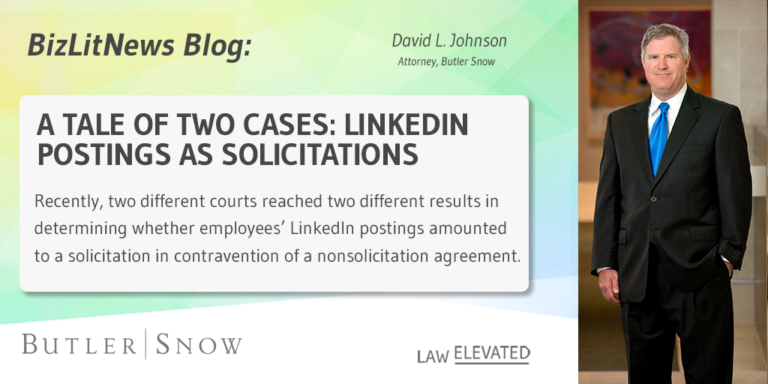Recently, two different courts reached two different results in determining whether employees’ LinkedIn postings amounted to a solicitation in contravention of a nonsolicitation agreement. In Bankers Life & Cas. Co. v. Am. Senior Benefits LLC, 83 N.E.3d 1085 (Ill. App. Ct. 2017), Greg Geliuni left his employer, Bankers Life, to join a competitor, ASB. Thereafter, he sent “invitations” to certain of his former co-workers to join his LinkedIn network. Geliuni’s LinkedIn page included a job posting for his new employer, such that anyone who connected with him could see the posting.
Bankers Life claimed that Geliuni violated the terms of an employment agreement prohibiting him from soliciting co-workers. The Illinois Appellate Court concluded that Geliuni didn’t solicit his former co-workers simply by sending them LinkedIn invitations. According to the court, the “generic” email invitations “did not contain any discussion of Banker’s Life, no mention of ASB, no suggestion that the recipient view a job description on his on Geliuni’s profile page, and no solicitation to leave their place of employment and join ASB.”
A Minnesota federal district court reached a different conclusion in Mobile Mini, Inc. v. Vevea, 2017 WL 3172712 (D. Minn. July 25, 2017). In that case, Liz Vevea left her job with Mobile Mini to join Citi-Cargo, a competitor in the portable self-storage business. During the time period in which she was bound by a nonsolicitation provision, Vargo issued a LinkedIn post indicating that she had joined Citi-Cargo, touting the company, and concluding: “Give me a call today for a quote.” Thereafter, she released another LinkedIn post stating: “Call me today for a storage container quote from the cleanest, newest, safest and best container fleet in the State of Minnesota. Let’s connect!”
The Minnesota court found that Vevea crossed the line. Noting that Mobile Mini customers were included in Vevea’s LinkedIn network, the court stated that “the posts are not mere status updates,” but instead “blatant sales pitches.” “Instead of merely announcing a job change, the language of the posts here demonstrates that Vevea’s purpose was to entice members of Vevea’s network to call her for the purpose of making sales in her new position at Citi-Cargo.”
So what can we learn from these cases? It should be ok for an employee bound by a nonsolicitation covenant to issue social media posts about a job change or to send generic messages inviting others to join his or her social media network. When an employee’s behavior is not passive, but instead active, things become more risky. Unique messages specifically targeting off-limits persons will be scrutinized closely. Further, it’s quite possible that a court would deem a broad social media post to the former employee’s entire social media network to violate a nonsolicitation covenant if the post is designed to lure people to the new employer and “off limits persons” are members of the former employee’s social network. Therefore, employees bound by nonsolicitation covenants should tread very carefully on social media.
Authored by David L. Johnson

